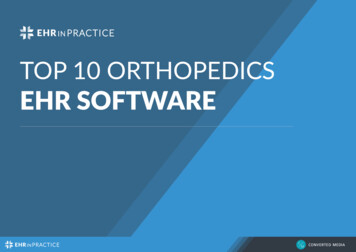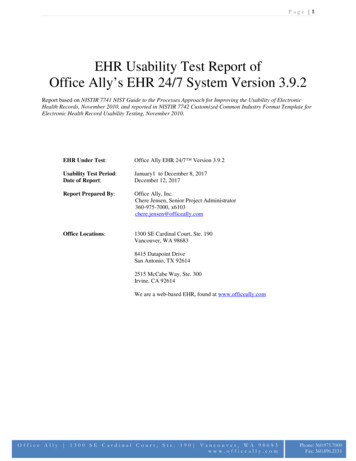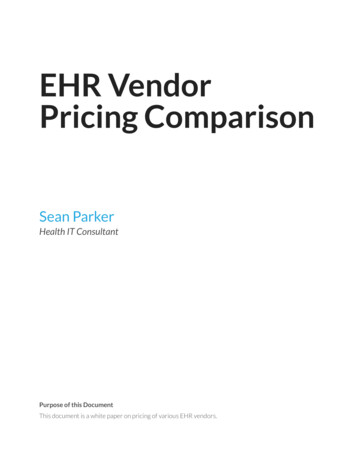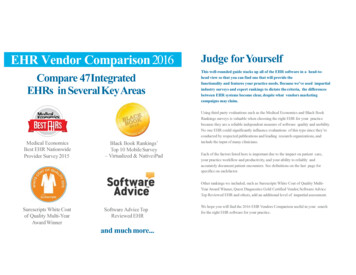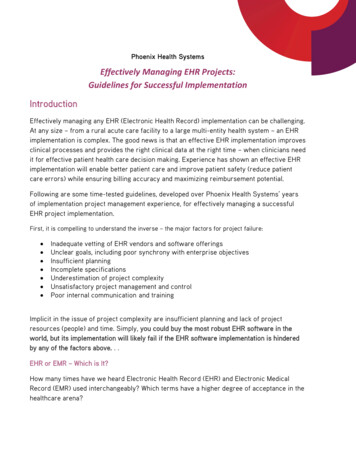
Transcription
Phoenix Health SystemsEffectively Managing EHR Projects:Guidelines for Successful ImplementationIntroductionEffectively managing any EHR (Electronic Health Record) implementation can be challenging.At any size – from a rural acute care facility to a large multi-entity health system – an EHRimplementation is complex. The good news is that an effective EHR implementation improvesclinical processes and provides the right clinical data at the right time – when clinicians needit for effective patient health care decision making. Experience has shown an effective EHRimplementation will enable better patient care and improve patient safety (reduce patientcare errors) while ensuring billing accuracy and maximizing reimbursement potential.Following are some time-tested guidelines, developed over Phoenix Health Systems’ yearsof implementation project management experience, for effectively managing a successfulEHR project implementation.First, it is compelling to understand the inverse – the major factors for project failure: Inadequate vetting of EHR vendors and software offeringsUnclear goals, including poor synchrony with enterprise objectivesInsufficient planningIncomplete specificationsUnderestimation of project complexityUnsatisfactory project management and controlPoor internal communication and trainingImplicit in the issue of project complexity are insufficient planning and lack of projectresources (people) and time. Simply, you could buy the most robust EHR software in theworld, but its implementation will likely fail if the EHR software implementation is hinderedby any of the factors above. . .EHR or EMR – Which is It?How many times have we heard Electronic Health Record (EHR) and Electronic MedicalRecord (EMR) used interchangeably? Which terms have a higher degree of acceptance in thehealthcare arena?
Though arguably equivalent terms, we have chosen to use the EHR, as defined by the HealthInformation and Management Systems Society (HIMSS):"The Electronic Health Record (EHR) is a secure, real-time, point-of-care,patient-centric information resource for clinicians. The EHR aids clinicians’decision making by providing timely access to patient health record informationand by incorporating evidence-based decision support. The EHR automates andstreamlines the clinician’s workflow, closing loops in communication andresponse that result in delays or gaps in care. The EHR also supports thecollection of data for uses other than direct clinical care, such as billing, qualitymanagement, outcomes reporting, resource planning, and public health diseasesurveillance and reporting."Basically, the EHR is the patient's health record - cradle to grave - in electronic (computer) form.An EHR is a comprehensive, integrated set of clinical processes, which require operationalchange. The goal of an EHR implementation is safer and more effective patient care. TheEHR is generally not considered “owned” by any one physician. From a regional orcommunity health perspective, the EHR is seen as integrated “pieces of information” whichcan be provided by any or all of the following: Hospital facilitiesFamily/primary care physicianSpecialist(s)LabsRadiology facilitiesPharmaciesInsurance carriers/health plansThe EHR is a longitudinal record of an individual patient’s health record -- the sum of thepatient’s total experiences in the community.First Things First: Establish a Project Management FrameworkSuccessfully implementing an EHR involves more than selection, signing a contract andinstalling the software. Begin the implementation process as a project with the discipline of aproject management framework around it. If your organization does not have IT staff withdeep experience in implementation project management, you many need to bring in externalEHR implementation specialists to manage it.For large, complex projects with many system and process interfaces, a ProgramManagement Office (PMO) should be considered to conduct all aspects of the EHRimplementation.
Large or small, according to the Project Management Institute (PMI), best practicesprocesses cover: ProcurementInitiationPlanningExecutingMonitoring and controllingClosing1. Procurement Undertaking the EHR procurement process is one of the most critical aspects ofmoving to a new operational environment. Negotiating your purchase and attendantdeliverables is typically a daunting process that is complicated by vendor pressuresand competition, as well as legal complexities. Your leadership may feeluncomfortable in this environment; if so, an external consultant with strongexperience in systems procurement may save major expense and long termvulnerability. Select a vendor partner who can offer expert knowledge, committed and sufficientimplementation support and training, and a flexible and customizable approach to yourpeople and processes. Ensure that the vendor will address existing patient dataconversion and software interfaces. When vetting EHR vendor options, you must understand the feasibility of the softwarefunctionality. How does its intended functionality perform in operation elsewhere?How will your current processes be impacted by the desired outcomes of “futurestate” functions? An EHR example would be the impact of “point and click” templatesthat help input patient data electronically using mobile devices at the point of care.2. Initiation One of the keys to a successful EHR implementation is creating a project team tomanage the EHR implementation project process. First, select your organization’sproject manager. This should be a person with an extensive experience in managinghealth care projects. Preferably, the project manager should be a certified as aProject Management Professional (PMP), a designation offered by the ProjectManagement Institute, an internationally respected, standards-based professionalorganization.
Next, identify key project stakeholders. Project success depends on the selection ofthe right internal leadership. In the EHR implementation realm, this should includeyour organization’s Board, executives, and leadership -- representing physicians,nursing, and clinicians in the inpatient, outpatient (clinics), emergency and ancillarydepartmental areas. As the members of the EHR Committee, they will oversee theproject and the project team. They will make decisions to address any high-levelissues that may arise. From the beginning, the EHR Committee needs to “buy in” tothe EHR. Ideally, the project will be championed by your organization’s chiefphysician(s) with a strong commitment to project success. You should understand your organization’s culture and its degree of acceptance totechnical and process change resulting from computer-based processes. In an EHRimplementation, learning new clinical flow processes will be key, and for many staffmembers, difficult. Training efforts should be estimated at 25 to 35percent of thework effort. Management and staff commitment to learn and implement new staffprocesses must be a given from the start, and remain constant through the project. It is fundamentally important to analyze and fully understand your organization’s“current state” processes at the outset. How are you currently doing orders, chargecapture and billing, flow sheets, and medication administration records? How is yourpatient chart data recorded? How does your current system and operation integrateits functionality internally and externally with radiology, labs and pharmacies? Are theprocesses consistent and standardized across the continuum of care? Where are theprocesses inconsistent? Determine and document the driving vision, business need, and related regulatorymandates such as Meaningful Use and project objectives. There should be articulationand documentation of specific project goals, including: Best possible care and clinical outcomes for patientsPatient safetyPatient satisfactionUser satisfactionRetention of talented staffSound financial performanceSolid data securityRealization of Meaningful Use goalsRealization of other strategic enterprise objectivesConfidence of the communitySelect a project team that has the requisite clinical and technical skills to do the workand represents the areas in your organization that will maintain and use the EHR.This will include a mix of clinical and patient management/billing people, generally the“super-users” that will lead the project implementation in their areas and train theirassociates.
Finally, you will need to analyze, understand and document the scope of the project.This would include any assumptions, constraints, or any other influences on theproject. An example could be the project budget. These influences can be related togovernmental regulations, finances or safety. As the project proceeds, scopemanagement will help the project from suffering from “scope creep.”3. PlanningA project plan should address everything from workflow to project schedules, on tohardware/ software selection and installation, and finally to staff training. This is where thepreliminary scope statement is finalized, documented and presented to the EHR Committee. Quality standards should be determined to measure the before and after projectimprovements – such as reduced patient care errors, no lost or misplaced charts,zero transcription errors and shortened length of stay. Before selecting EHRsoftware, identify the problems in your organization that should be corrected andcollect baseline data. Be specific and identify measurable goals. An EHRimplementation can yield a large number of clinical, financial and organizationalimprovements. In the planning process, your organization’s project manager should determine yourproject team’s roles and responsibilities, and clearly communicate these expectationsto the project team members in your project kick-off meeting. Your organization’s EHR project manager will need to set the groundwork for strongcommunications throughout the project. This will require developing acommunications plan that addresses the needs and concerns of stakeholders.Consider which will be more appropriate: formal presentations, speeches, projectplans, and status memos; informal e-mails, meetings and conversations; or somecombination. The EHR Committee, stakeholders and project team need to consider the risksinherent in the project. One example could be that the physicians using the EHR areresistant to adopting the new processes and begin admitting patients at otherfacilities. Examine contingencies or other remedies to mitigate risks; in this example,a contingency could be to recruit physicians experienced in using an EHR. EHR project planning needs to consider technical platform requirements and peopleand process requirements. Examples of hardware requirements are mobile devices inthe clinical areas, identifying network and wireless changes, and setting up thecentral computer room or command centers. Examples of people and processimprovement requirements are redesigning workflows and then building andinstalling the software to support these new workflows. Also, training, proceduresand documentation are necessary to effectively make the re-designed work flowsoperational.
The technical, people and process requirements need to be translated into workpackages (defined activities and tasks) that are observable and measurable. Yourexperienced project manager will use these work packages in leading the estimationeffort so that it may be translated into a project schedule. Once this schedule isbaselined, project costs and expended resource time will be able to be monitored,measured and controlled.Once your organization’s EHR project manager has completed the project plan, yourorganization is ready to start the “Executing” phase of the EHR process.4. ExecutingWhen executing a successful EHR project, you must consider your infrastructural readiness,application configuration readiness, and training readiness. Appropriate hardware must bein place well before your live implementation. These should include adequate workstations,printers, servers and wireless devices, and related security measures. Prior to live implementation, you should execute your detailed test plan. This wouldinclude functional, integration and volume testing. Integration testing should includeall the functional elements and their interfaces. Application configurations need toinclude workflows, procedures and all areas of the clinical record design. Volumetesting should be done on the future state hardware platform. This is important toensure adequate infrastructure and computing resources to support the EHR project. Be sure to allocate enough time for adequate training, which will have to be managedaround the users’ schedules and workloads. If possible, designate training rooms andclasses away from the clinical areas. Designate super users in all areas during the“Go Live,” to extend the implementation staff’s capabilities and champion the goals ofthe project. Evaluate staff readiness before making the decision to go live.5. Monitoring and ControllingUsing metrics for EHR effectiveness, you must compare existing costs to your process costsafter implementation. Metrics on quality and cost are necessary for measuring EHReffectiveness in making clinical data more accessible and interchangeable. Theeffectiveness of training also should be measured, using competency tests before EHRaccess is authorized to a user. Change control is a critical factor in gaining EHR project execution stability. Withsuch sophisticated technology and other interdependent systems, any small change inone system has the potential to affect the perception of their operational stability.
A responsive help desk and a problem tracking and daily status reporting system willbe essential in maintaining stability. Status reporting will improve communications aswell as aid in assigning responsibilities and priorities.6. Closing the ProjectOfficially closing projects is a best practice articulated by the Project Management Institute.In addition to obtaining formal acceptance, the project manager should measure customersatisfaction, which in the case of EHRs, would apply to clinical users. Are physicians andnurses achieving the goals and objectives of the project? Is this measured in terms of easeof use, more effective and efficient patient chart tracking, and patient safety? If achievingprogress in Meaningful Use is pertinent, can this progress be documented? In closing theproject, formal project sign-off from users and other stakeholders is should be considered amajor goal. Are the appropriate project functions being formally turned over to the users and ITfor their ongoing processes? To complete the project, all project resources (peopleand equipment) need to be released back to your organization’s departments. Documenting “lessons learned” should also be done in the project closing period.Should the project manager have allocated more time and resources for training?Were the new workflow processes well-documented and consistent across theorganization? The “lessons learned” historical documentation will serve as a veryhelpful reference for future organizational projects.In Summary -- successful EHR projects share these key elements: Vendors that bring value to the EHR implementation “table”Given the complex nature of EHR implementation, your organization should work withvendors who bring expertise and a flexible, customized approach. This should includeknowledge of the IT marketplace, including software, hardware, security and Internetconnectivity. Vendors should also have capabilities relating to issues such as HIPAA,Meaningful Use, potential ACO participation, and patient management and billing. Project management framework and discipline establishedIncorporate project management principles and structure, as promulgated by theProject Management Institute (PMI), into your EHR project. From the very start, anexperienced project manager should be engaged on the project. If the project is largeand complex, consider using a Program Management Office (PMO.)
Clinical project driven by clinicians and supported by ITThe EHR must be a number one organizational priority. Physicians, nurses and otherclinicians need to provide leadership in the communication, planning, building,process redesign and implementation of the EHR. Project direction can be driven byan EHR committee led by chief physicians and IT, which will provide the neededproject, network and application implementation support. Full-scale analysis of the current state and re-design of all clinical processes for thefuture stateTo help ensure a successful implementation, involve clinicians in the modification ofyour current-state EHR. Design, modification and enhancement priorities need to beprimarily the decisions of multi-disciplinary clinician design teams. These teamsshould possess a sense of project ownership and focus on the future state -improving clinical processes, user effectiveness and efficiency, enhancing patientsafety, and achieving Meaningful Use objectives. Comprehensive training planA comprehensive training plan that addresses EHR functionality and computer basicsis essential for success. Plan between 25 and 35 percent of work effort for thisproject. Complete clinical adoption across the organization of the EHR projectThe way to ensure adoption by clinicians is to involve them in every aspect of theEHR project, e.g., system selection and procurement, process redesign, pilots andtraining. Their project involvement should be encouraged as much as possible sothat they can clearly see the EHR project value and benefits to them. Documented and justified Return on Investment (ROI)Document and clearly define the EHR system’s ROI. Use hard metrics such as thevalue of electronic order entry and eliminating transcription errors as a means ofmeasuring your EHR project ROI. Communication, leading and collaborationFoster an organizational culture of trust and collaboration, across administration,clinicians and IT. A positive attitude - with the goal of a successful project – isessential. Clearly communicate the project vision and goals and obtain stakeholder“buy-in.” Define a project framework with clearly defined roles and responsibilities.Foster and reward teams that will work well together to achieve project goals.
Expect EHR project complexity and factor it into project planningEstimating and allowing for the project’s complexity – by committing the neededresources and consistently communicating to stakeholders - is a critical successfactor. A clearly defined project plan and scope statement will control and preventunanticipated demands on resources as a result of “scope creep.”About Phoenix Health Systems:Phoenix Health Systems offers a comprehensive range of professional IT services focusedon creating a positive clinical, operational and business impact for every hospital client. Ourdepth of experience spans the complete range of IT-related challenges facing both large andsmall hospitals in. Phoenix brings: Over two decades of senior level leadership and hands-on knowledge of hospitaloperations and related technologiesProven top-of-the-industry methodologies and toolsNimble, personalized collaboration with every client’s C-Suite to achieve enterpriseobjectivesA passion for improving quality of patient care, patient safety, and the bottom lineA deep understanding of Meaningful Use mandates and benefits -- and otherregulatory requirementsAn energized perspective on the future of healthcareA commitment to keeping our promisesHTTP://www.phoenixhealth.comDavid Lewis, Senior Vice President, Client Services1130 E. Arapaho Road, Ste. 500, Richardson, TX 75081 O: 214 261-0660 F: 214 231-6036 phoenixhealth.com2012 Copyright, Phoenix Health Systems. All Rights Reserved.
deep experience in implementation project management, you many need to bring in external EHR implementation specialists to manage it. For large, complex projects with many system and process interfaces, a Program Management Office (PMO) should be considered to conduct all aspects of the EHR implementation.
